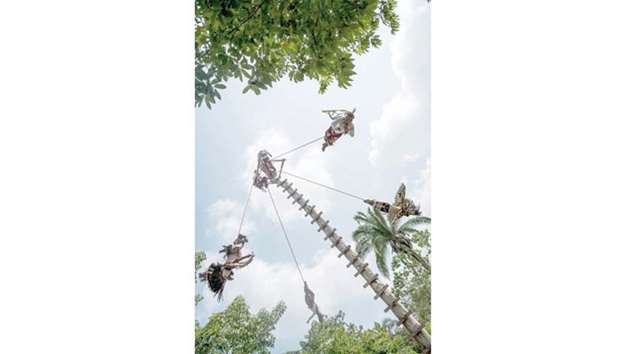Heriberto opens the wings attached to his arms and leans his head backwards.
One last look at the sun, and the Mexican volador (flier) lets himself fall head first from a platform 20 metres high.
Only a yellow rope tied around his waist sustains the 29-year-old as he twirls around the pole upholding the spinning platform he jumped from, gradually lowering himself to the ground. At the last minute, he swings upright and lands safely on his black leather boots.
“I feel very proud to be able to represent this tradition,” Heriberto says about the ceremony that he and three other voladores performed in Papantla in eastern Veracruz state, where it is popular among the Totonac people. It is also performed by other ethnic groups in Mexico and Central America, including the Maya in Guatemala.
Mexico has about 1,000 voladores, including 50 women, according to a cultural centre presenting Totonac traditions in Takilhsukut Park near El Tajin archaeological site. In addition, about 200 children are currently studying to become voladores in special schools around the country, one of which operates in the park itself.
Madai, 11, proudly shows off her bird costume. She was a little afraid at first, she admits, but now she can hardly wait to display her skills. “I like the fact that this tradition is passed on from generation to generation,” she says.
The students are not only taught to perform the ceremony, they also study the language of the Totonac – an ethnic group comprising about 400,000 people – and the history of the ritual, a teacher explains.
Heriberto, whose almost entire family belongs to voladore groups, started practising “flying” at age 5. “Our costumes are based on the original ones that existed before the Spaniards arrived in Mexico,” he says.
The costumes represent eagles, owls or the Latin American quetzal birds. The Spanish conquerors contributed red pants, a white shirt and headgear with colourful ribbons, which flap in the wind like the wings of a bird, according to sources at the cultural centre.
The ceremony of the voladores is believed to date from pre-Colombian times. It seeks to express respect and harmony with the natural and spiritual worlds, according to the UN Educational, Scientific and Cultural Organization (Unesco), which listed the ceremony as forming part of the world’s intangible cultural heritage in 2009.
The tradition was born at the time of a drought in Veracruz, as legend has it. The elders were trying to find a way of appeasing the deity and sent a group of men to find the highest tree in the forest.
The tree was hacked down and blessed with a dance before being taken to the village, where it was turned into a pole. Four men – the first voladores – then climbed the pole, each representing one of the four cardinal directions.
Today, the poles can be up to 40 metres high, and the ceremony is certainly not without danger.
An average of one volador is killed every year, according to Salomon Bazbaz, a spokesman for the cultural centre in Takilhsukut.
The most dangerous role is that of the caporal, who stands on the platform and plays a small drum and a flute to the sun and the four winds while the other voladores fling themselves off into the air.
Most of the accidents occur when equipment is being taken up to the platform, Bazbaz explains.
But despite such risks, Mexicans would never consider giving up the ceremony, which does nothing less than “brings to life the myth of the birth of the universe,” as Unesco puts it. – DPA

BIRDS: The voladores’ costumes represent eagles, owls or the Latin American quetzal birds.
